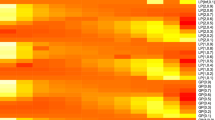Abstract
In this paper, a fresh multi-attribute decision-making (MADM) method is proposed for group-oriented decision analysis. For group-oriented multi-attribute decision-making (GOMADM) problems, this paper proposes local advantage–disadvantage degrees and advantage–disadvantage degrees from the perspective of a strict attribute containing relation between group members and other group members, and studies the related properties. Based on the above two degrees, a new GOMADM method is designed, and this method is locally optimized according to the related properties. Finally, an example is used to analyze the rationality of the GOMADM method, and their ranking results are comparatively analyzed and discussed.



Similar content being viewed by others
References
Figueira, S., Greco, J., Ehrgott, M.: Multiple Criteria Decision Analysis: State of the Art Surveys. Springer, New York (2005)
Behzadian, M., Otaghsara, S.K., Yazdani, M., Ignatius, J.: A state-of-the-art survey of topsis applications. Expert Syst. Appl. 39(17), 13051–13069 (2012)
Opricovic, S., Tzeng, G.H.: Compromise solution by MCDM methods: a comparative analysis of vikor and topsis. Eur. J. Oper. Res. 156(2), 445–455 (2004)
Roy, B.: The outranking approach and the foundations of electre methods. Theor. Decis. 31(1), 49–73 (1991)
Brans, J., Vincke, P.: A preference ranking organization method (the PROMETHEE method for multiple criteria decision-making). Manag. Sci. 31(6), 647–656 (1985)
Murat, S., Kazan, H., Coskun, S.: An application for measuring performance quality of schools by using the promethee multi-criteria decision making method. Procedia Soc. Behav. Sci. 195, 729–738 (2015)
Jacquetlagreze, E., Siskos, J.: Assessing a set of additive utility-functions for multicriteria decision-making, the uta method. Eur. J. Oper. Res. 10(2), 151–164 (1982)
Saaty, T.L.: A scaling method for priorities in hierarchical structures. J. Math. Psychol. 15(3), 234–281 (2000)
Saaty, T.L.: Decision making - the analytic hierarchy and network processes (AHP/ANP). J. Syst. Sci. Syst. Eng. 13(1), 1–35 (2004)
Costa, B.E.: Macbeth—an interactive path towards the construction of cardinal value functions. Int. Trans. Oper. Res. 1(4), 489–500 (2010)
Greco, S., Matarazzo, B., Slowinski, R.: Rough approximation of a preference relation by dominance relations. Eur. J. Oper. Res. 117(1), 63–83 (1999)
Greco, S., Matarazzo, B., Slowinski, R.: Rough sets theory for multicriteria decision analysis. Eur. J. Oper. Res. 129(1), 1–47 (2001)
Greco, S., Inuiguchi, M., Slowinski, R.: Fuzzy rough sets and multiple-premise gradual decision rules. Int. J. Approx. Reason. 41(2), 179–211 (2006)
Greco, S., Matarazzo, B., Slowinski, R.: Dominance-based rough set approach to case-based reasoning. In: International Conference on Modeling Decisions for Artificial Intelligence, pp. 7–18. Springer (2006)
Huang, Q., Li, T., Huang, Y., Yang, X., Fujita, H.: Dynamic dominance rough set approach for processing composite ordered data. Knowl.-Based Syst. 187, 104829 (2020)
Palangetić, M., Cornelis, C., Greco, S., Słowiński, R.: Fuzzy extensions of the dominance-based rough set approach. Int. J. Approx. Reason. 129, 1–19 (2021)
Błaszczyński, J., Filho, A., Matuszyk, A., Szelag, M., Słowinski, R.: Auto loan fraud detection using dominance-based rough set approach versus machine learning methods. Expert Syst. Appl. 163, 113740 (2021)
Zhang, C., Li, D., Liang, J.: Hesitant fuzzy linguistic rough set over two universes model and its applications. Int. J. Mach. Learn. Cybern. 9(4), 577–588 (2018)
Zhang, C., Li, D., Liang, J.: Multi-granularity three-way decisions with adjustable hesitant fuzzy linguistic multigranulation decision-theoretic rough sets over two universes. Inf. Sci. 507, 665–683 (2020)
Ahmad, A., Qamar, U., Raza, M.: An optimized method to calculate approximations in Dominance based rough set approach. Appl. Soft Comput. 97, 106731 (2020)
Kusunoki, Y., Błaszczyński, J., Inuiguchi, M., Słowiński, R.: Empirical risk minimization for dominance-based rough set approaches. Inf. Sci. 567, 395–417 (2021)
Chandra, P.: Investment Analysis and Portfolio Management. McGraw-hill education, New York (2017)
Grinold, R., Kahn, R.: Active Portfolio Management. McGraw Hill, New York (2000)
Bartling, B.: Relative performance or team evaluation? Optimal contracts for other-regarding agents. J. Econ. Behav. Organ. 79(3), 183–193 (2011)
Entin, E., Entin, E.: Measures for evaluation of team processes and performance in experiments and exercises. In: Proceedings of the 6th International Command and Control research and Technology Symposium, pp. 1–14 (2001)
Teller, J.: Portfolio risk management and its contribution to project portfolio success: an investigation of organization, process, and culture. Proj. Manag. J. 44(2), 36–51 (2013)
Teller, J., Kock, A.: An empirical investigation on how portfolio risk management influences project portfolio success. Int. J. Project Manag. 31(6), 817–829 (2013)
Zheng, Y., Zheng, J.: A novel portfolio optimization model via combining multi-objective optimization and multi-attribute decision making. Appl. Intell. 52(5), 5684–5695 (2022)
Liang, Y., Qin, J., Martínez, L.: Consensus-based multicriteria group preference analysis model with multigranular linguistic distribution information. IEEE Trans. Fuzzy Syst. 28(12), 3145–3160 (2020)
Xu, BYu.Z.: Advantage matrix: two novel multi-attribute decision-making methods and their applications. Artif. Intell. Rev. (2022). https://doi.org/10.1007/s10462-021-10126-9
Yu, B., Xu, Z., Dai, J., et al.: A novel multi-attribute decision-making method based on neighborhood approximations and its application. Expert Syst. Appl. 199, 116946 (2022)
Robbins, S., Judge, T.: Essentials of Organizational Behavior. Pearson, Boston (2012)
Gomes, L., Rangel, L.: An application of the todim method to the multicriteria rental evaluation of residential properties. Eur. J. Oper. Res. 193(1), 204–211 (2009)
Brauers, W., Zavadskas, E.: The MOORA method and its application to privatization in a transition economy. Control. Cybern. 35, 445–469 (2006)
Acknowledgements
This work is supported by Hunan Provincial Natural Science Foundation of China (2020JJ5346).
Author information
Authors and Affiliations
Corresponding author
Rights and permissions
About this article
Cite this article
Yu, B., Xu, R., Fu, Y. et al. A Novel Dominance-Based Rough Set Model with Advantage (Disadvantage) Neighborhoods and Its Applications to Assess Sales Group. Int. J. Fuzzy Syst. 24, 3501–3512 (2022). https://doi.org/10.1007/s40815-022-01342-8
Received:
Revised:
Accepted:
Published:
Issue Date:
DOI: https://doi.org/10.1007/s40815-022-01342-8




